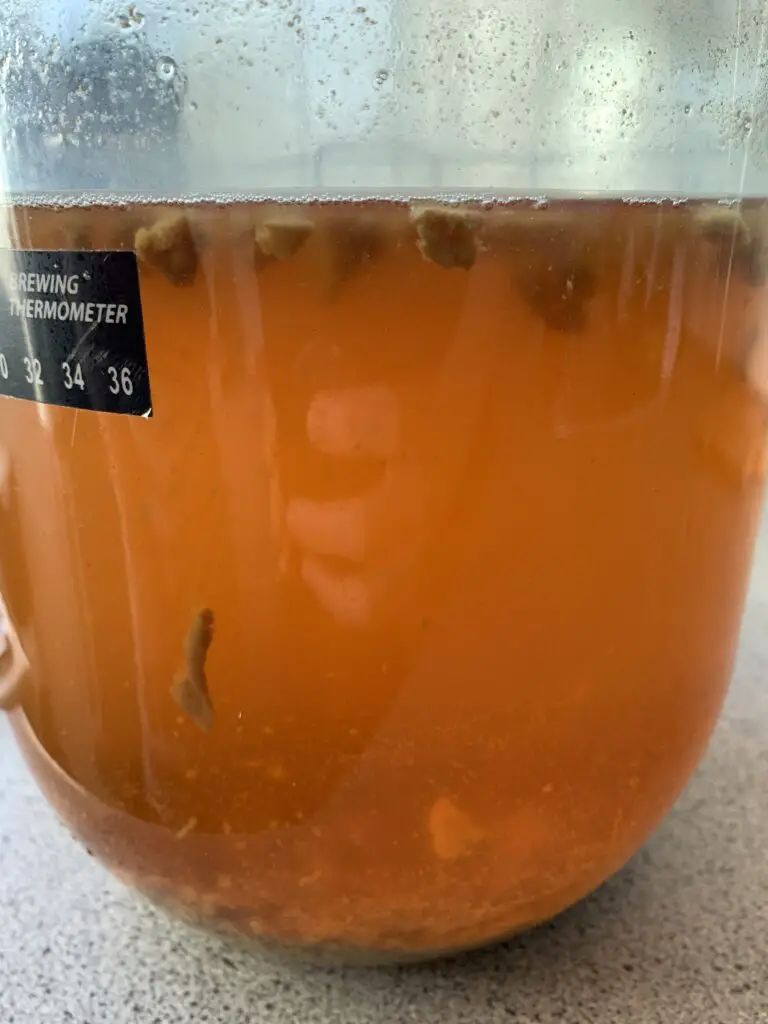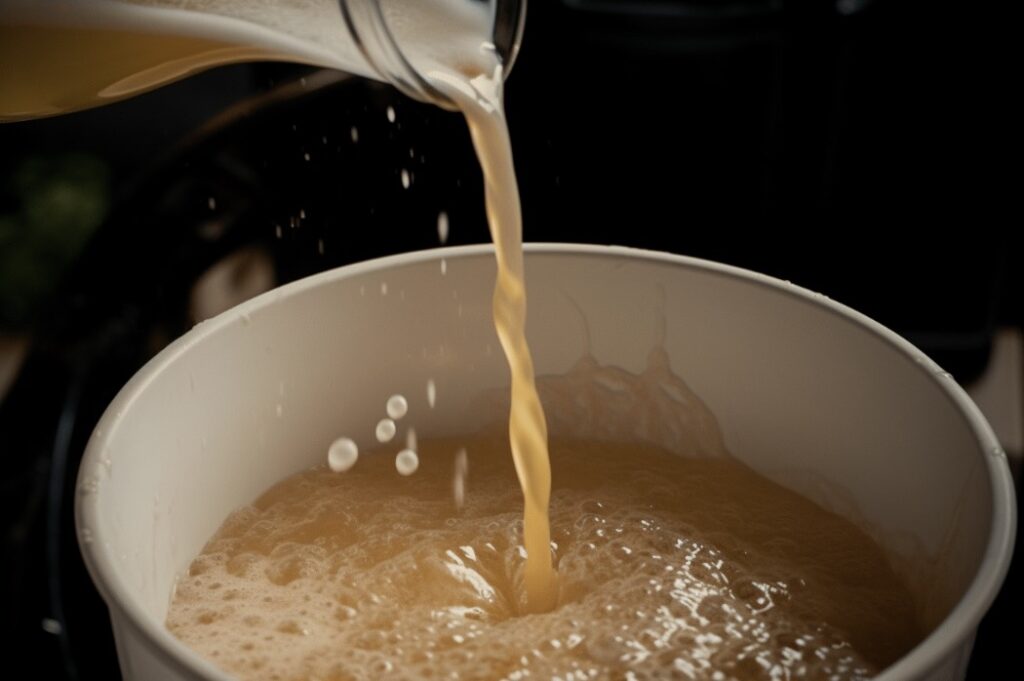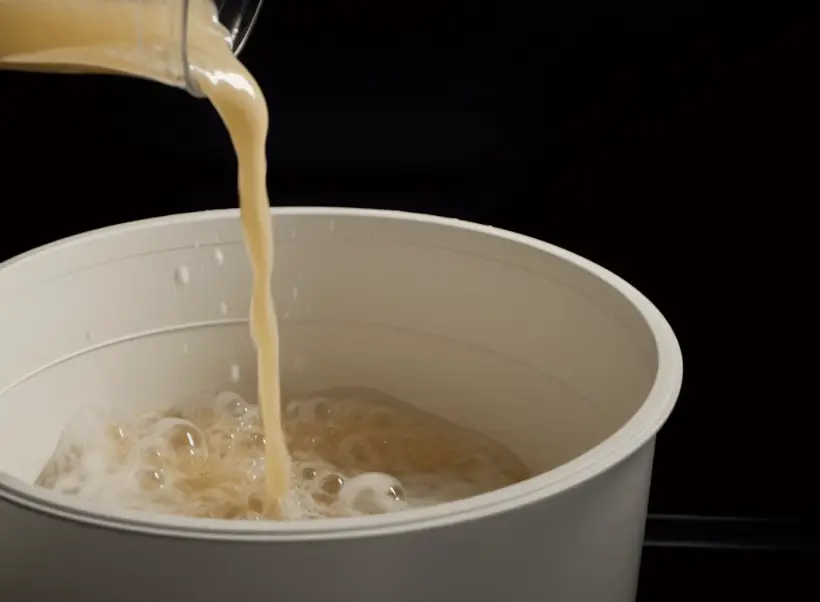Mead, a delightful alcoholic beverage crafted from fermented honey, has a rich history dating back centuries. While mead-making shares some fundamental principles with cider production, yeast plays a crucial role in initiating the fermentation process in both cases.
Adding an excessive amount of yeast to your mead may kickstart fermentation and accelerate the brewing process, but it is more likely to be unnecessary and can even ruin your mead.
It’s important to exercise caution because too much yeast can lead to issues such as too rapid fermentation, excessive foaming, elevated temperatures, and potential off-flavors as the yeast dies off prematurely.
In summary, while it is permissible to add a substantial amount of yeast to mead, it’s essential to strike the right balance. Consider using an appropriate yeast quantity and contemplate the inclusion of yeast nutrient to ensure a healthy fermentation.
So, grab a glass of your favorite mead, and let’s delve into the world of yeast in mead-making!
The Effects of Excessive Yeast in Mead
Overloading your mead with yeast can have adverse effects on the flavor, aroma, and appearance of your final product.
Excessive yeast growth can lead to off-flavors and aromas, including an undesired increase in alcohol content, elevated methanol levels, or aggressive foaming that results in fermentation vessel overflow.
Furthermore, an abundance of yeast can cause your mead to appear cloudy. Maintaining control over yeast levels is critical to enhancing the quality of your mead.
When deciding on the yeast quantity for mead fermentation, factors such as yeast type, mead recipe, and fermentation temperature must be considered. Using too much or too little yeast can result in undesirable consequences like off-flavors, stalled fermentation, and excessive carbonation.
However, it’s essential to remember that the majority of yeast cells are generated through cell division during the fermentation process.
Typically, yeast will double around 10 times in a day under optimal conditions, with the growth rate being highest initially and gradually stabilizing. So, while the initial yeast quantity matters to some extent, the final yeast mass in well-supported substrate remains relatively consistent.
Therefore it is crucial to remember that the majority of yeast in mead is not derived from the initial yeast addition but rather from yeast cells dividing during fermentation!

Typically, yeast doubles approximately ten times per day under ideal conditions. This process accelerates at the outset and gradually stabilizes into an equilibrium, where an equal number of yeast cells die and reproduce.
For instance, if you introduce 1 gram of yeast into a 1-gallon flask, assuming a maximum yeast density of 10^9 cells per ml (provided you have quality honey with added yeast nutrients!), you will have approximately 50mg of yeast per ml at the peak of fermentation (late log phase, as illustrated above!).
This equates to a final yeast weight of 0.05g x 3,785.41 milliliters = 189.27 grams of yeast mass at the zenith of fermentation (roughly!).
While these calculations are approximations, the key takeaway is that regardless of whether you initially add 1 or 10 grams of yeast, you will ultimately have at least 200 grams (7 oz) per gallon (53 grams per liter) in a supportive substrate.
The initial yeast quantity has minimal influence on this final number. However, it can impact the speed at which you reach that point.
If you are more interested in the mathematics behind yeast and fermentation speed, take a look at my slightly more nerdy post on whether adding more yeast will speed up fermentation (and how much!).
Therefore, while pitching the right amount of yeast is important, you can save resources by avoiding excessive yeast, and if needed, add more later if you encounter fermentation issues.
Yeast Overgrowth and Off-Flavors in Mead
Excessive yeast in mead can lead to undesirable off-flavors and aromas. It may result in a yeasty taste that overwhelms the natural flavors of your mead.

Adding a significant amount of yeast early in the process can accelerate yeast cell breakdown, releasing metabolites, proteins, and DNA into the brew, all of which can affect the taste. This can be especially problematic if you’re using specific yeast strains to enhance your mead’s flavor or aroma.
Additionally, the byproducts of overenthusiastic yeast activity can produce aromas ranging from bready or doughy to sulfuric or reminiscent of rotten eggs.
In essence, an excess of yeast can disrupt the delicate balance of flavors and aromas in your mead, emphasizing the importance of using an appropriate yeast quantity to avoid potential negative outcomes.
Yeast Overgrowth and Higher Alcohol Content in Mead
When making mead, it’s crucial to consider the quantity of yeast used, as excessive yeast can lead to unwanted consequences, including a higher alcohol content than desired.
Yeast overgrowth can prolong fermentation beyond what is necessary, resulting in a mead with a higher alcohol by volume (ABV) than intended. This can impart a harsh and excessively alcoholic taste, detracting from the desired flavor profile.
To achieve the desired taste and alcohol content in your mead, it’s imperative to exercise control over yeast levels by monitoring yeast quantities and fermentation duration.
Cloudy Appearance Caused by Excessive Yeast in Mead
If you’ve ever poured yourself a glass of mead and noticed it was hazy or cloudy, excessive yeast may be the culprit. An abundance of yeast can cause your mead to appear murky and unattractive.

Clumps of dead yeast cells tend to accumulate over time, especially when a significant quantity of yeast is added. This not only affects the mead’s appearance but can also introduce off-flavors and aromas. Precise yeast control is essential for producing high-quality, clear mead.
Determining the appropriate yeast pitching rates for your mead batch is crucial. Whether you use too much or too little yeast can impact the alcohol content and clarity of your mead. Striking the right balance will result in a clear and refreshing glass of mead.
Timing and Yeast Addition in Mead-Making
When it comes to crafting mead, timing is paramount to achieve the perfect balance of flavors and aromas. When deciding when to add yeast to your mead, factors such as temperature and juice acidity come into play.

Mead yeasts thrive at temperatures between 60-75°F, so maintaining your mead within this temperature range before yeast addition is essential.
Moreover, ensuring that your mead has the appropriate acidity level is crucial to promote healthy yeast growth. Once your mead reaches the right temperature and acidity level, it’s time to introduce your chosen yeast strain.
Exercise caution with the quantity you add, as excessive yeast can lead to a higher alcohol content and unwanted off-flavors.
Ultimately, successful mead fermentation hinges on achieving balance – adding the right amount of yeast at the right time can result in a delicious and well-rounded final product.
Remedying Mead with Proper Acidity and Extra Active Yeast
If your mead isn’t tasting right or has ceased fermenting, it may be “sick” due to acidity imbalances or excessive metabisulfite, rendering the yeast inactive. Fortunately, you can revive your mead with the proper steps.
Start by testing your mead’s acidity using a pH meter or acid test strips, and adjust it as needed with substances like sodium bicarbonate (baking soda) or calcium. Ensure that the pH doesn’t drop below 3, adding an alkaline agent if necessary to maintain a pH reading above 3.
Next, introduce a small amount of active yeast to jump-start fermentation and ensure a clean, consistent flavor profile.
If excessive sulfite is the issue, “air out” your mead by transferring it between vessels. This is best done when fermentation is at its initial stages, as prolonged exposure to oxygen can be detrimental in later stages of fermentation.
With proper care and attention, even “sick” mead can be salvaged and transformed into a delicious, refreshing beverage to savor.
Controlling Yeast Levels for Enhanced Mead Quality
Maintaining control over yeast levels in your mead can significantly enhance its overall quality. As previously discussed, excessive yeast can lead to off-flavors, higher alcohol content, and a cloudy appearance.
On the other hand, using too little yeast can result in incomplete fermentation and a lack of desired flavors. By carefully regulating the amount of yeast in your mead, you can achieve a harmonious balance that accentuates the natural flavors of the honey while still attaining a desirable alcohol content.
Removing yeast is a bit harder as it requires either filtering or killing it off using metabisulfites (campden) or, my favorite, cold crashing of your mead.
Moreover, controlling yeast levels can help you avoid issues related to spoilage and other pitfalls encountered during mead-making. Thus, don’t underestimate the importance of precise yeast control when aiming to produce high-quality mead that is both delicious and consistent.
How Much Yeast Should You Use for Mead?
The ideal quantity of yeast depends on factors such as the volume of mead you’re producing, your desired alcohol content, and the specific yeast strain being used.
As a general guideline, 1 gram of yeast per gallon of mead is typically good. However, for drier, higher-alcohol, or challenging-to-ferment mead, using 2-3 grams per gallon may be appropriate.
Remember that most yeast cells result from natural cell division during fermentation, so while the initial yeast quantity matters to some extent, the final yeast mass remains relatively consistent.
Finding the right yeast pitching rate can significantly improve the overall quality of your mead. To ensure a successful fermentation process, introduce the yeast when the mead is at room temperature and properly seal it with a stopper and airlock.
In the realm of yeast in mead production, moderation is key.
Factors to Consider for Yeast Pitching Rates
When determining the suitable yeast quantity for your mead, several factors must be considered. As previously mentioned, excessive yeast can lead to off-flavors, higher alcohol content, and a cloudy appearance.
Conversely, too little yeast can result in slow or stalled fermentation. Consider factors such as the volume of your mead, its specific gravity, and your desired alcohol content when calculating the yeast pitching rate.
Additionally, different yeast strains can impart varying tastes and aromas to your mead. Thus, careful consideration of these factors will enable you to determine the optimal yeast pitching rate, ensuring the production of the highest quality mead.
Potential Consequences of Yeast Imbalance in Mead Production
Using too much or too little yeast in mead production can have detrimental effects on your mead’s overall quality. Excessive yeast can lead to off-flavors, higher alcohol content, and a cloudy appearance.

Conversely, insufficient yeast can result in sluggish fermentation or even a fermentation stall. The appropriate yeast quantity varies based on factors such as your mead’s desired alcohol content, temperature, and sugar levels.
By maintaining precise control over yeast levels, you can enhance your mead’s overall quality and ensure a successful fermentation process.
Adding Large Amounts of Yeast vs. Risks of Adding Too Little Yeast
When it comes to adding yeast to your mead, finding the right balance is essential to achieving the desired flavor, aroma, and overall quality. Let’s explore the pros and cons of adding large amounts of yeast versus the risks associated with adding too little yeast.
Pros of Adding Large Amounts of Yeast:
- Accelerated Fermentation: Adding a substantial quantity of yeast at the beginning can kickstart the fermentation process, leading to a quicker turnaround for your mead. This can be advantageous if you’re aiming for a faster production timeline.
- Reduced Risk of Stalling: Larger yeast populations are less likely to experience fermentation stalls or delays. This can be particularly beneficial when working with challenging or high-alcohol mead recipes.
- Consistency: Using a generous amount of yeast can lead to more predictable and consistent fermentation outcomes, ensuring that your mead turns out as expected.
Cons of Adding Large Amounts of Yeast:
- Off-Flavors and Aromas: Excessive yeast can produce off-flavors and aromas, overpowering the natural characteristics of your mead. This can result in undesirable taste profiles and potentially compromise the quality of your mead.
- Higher Alcohol Content: Large yeast populations can lead to prolonged fermentation, resulting in a mead with a higher alcohol by volume (ABV) than intended. This can affect the balance and drinkability of your mead.
- Cloudy Appearance: Mead with an abundance of yeast may appear cloudy, diminishing its visual appeal. Clumps of dead yeast cells can accumulate over time, causing cloudiness and potential off-flavors.
Risks of Adding Too Little Yeast:
- Sluggish Fermentation: Insufficient yeast can lead to slow or stalled fermentation. This can significantly prolong the fermentation process, increase the risk of bacterial contamination, and result in incomplete fermentation.
- Off-Flavors from Stressed Yeast: Underpitching yeast can stress the yeast population, leading to the production of off-flavors and undesirable aromas in your mead.
- Inconsistent Results: Using too little yeast can result in inconsistent fermentation outcomes, making it challenging to predict the final flavor and quality of your mead.
Finding the Right Balance:
The key to successful mead production lies in striking the right balance between yeast quantity and other factors. Consider the specific characteristics of your mead recipe, such as desired alcohol content, sweetness level, and yeast strain.
Additionally, monitor the fermentation process closely, adjusting yeast quantities as needed if you observe signs of slow or stalled fermentation. By carefully evaluating your mead’s unique requirements, you can ensure that it turns out both flavorful and well-balanced.
Conclusion
In conclusion, understanding the role of yeast in mead-making is essential for producing a high-quality and delicious final product. We’ve explored the key aspects of yeast management, including the effects of adding too much yeast and the risks associated with adding too little.
When considering the pros and cons of adding large amounts of yeast, we found that it can accelerate fermentation, reduce the risk of stalling, and provide consistency in the brewing process. However, it also comes with the potential drawbacks of off-flavors, a higher alcohol content, and a cloudy appearance.
On the other hand, the risks of adding too little yeast involve sluggish fermentation, off-flavors from stressed yeast, and inconsistent results.
To achieve the perfect balance, it’s crucial to consider factors such as the mead recipe, desired alcohol content, fermentation temperature, and yeast strain. Careful monitoring of the fermentation process and the flexibility to adjust yeast quantities when necessary can help ensure a successful outcome.
In the world of mead-making, yeast control is an art that allows you to enhance the natural flavors of your honey-based brew while achieving the desired alcohol content and clarity. By navigating the delicate balance between yeast quantity and quality, you can savor the rich and diverse world of mead with confidence and satisfaction.




